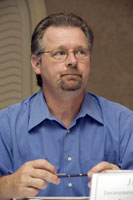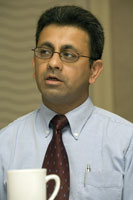
2008 Roundtable
The view from here looks positive for the environmental industry, despite the political uncertainties during this election year, say our pros
- By Angela Neville
- Feb 11, 2008
Overall, the members of Environmental Protection’s 2008 Environmental Roundtable expect economic advances in the environmental industry, especially in the water treatment and air pollution control sectors. That’s the story these 14 environmental executives told us at our annual roundtable on August 28, and they’re sticking to it.
To be sure, our experts have some concerns, including the challenges that many corporations experience in the face of uncertain regulatory controls on greenhouse gases.
Generally speaking, however, they predict strong growth related to many sectors, such as alternative energy development and technology that promotes sustainability.
In this article, they explain why and share their forecasts on other issues affecting the environmental industry.
The following excerpts have been edited for length and style.
 Jim Leary, environmental pipe products manager, Asahi/America Jim Leary, environmental pipe products manager, Asahi/America |
 Garvin Cox , central regional sales manager, Baysaver Technologies Garvin Cox , central regional sales manager, Baysaver Technologies |
 Jim Stone, director of sales, Durr Environmental and Energy Systems Jim Stone, director of sales, Durr Environmental and Energy Systems |
 Harry Favre, a consultant, Environmental Resource Center Harry Favre, a consultant, Environmental Resource Center |
 Bill Jayroe, director of Southeast Region, Environmental Support Systems Bill Jayroe, director of Southeast Region, Environmental Support Systems |
 Herschell Winfrey, North America sales manager for green buildings and water improvements, General Electric's Water & Process Technologies Herschell Winfrey, North America sales manager for green buildings and water improvements, General Electric's Water & Process Technologies |
 Connie Mixon, chief executive officer, MYCELX Technologies Connie Mixon, chief executive officer, MYCELX Technologies |
 Bill Radosevich, environmental marketing manager, Thermo Fisher Scientific Bill Radosevich, environmental marketing manager, Thermo Fisher Scientific |
 Jim Norgaard, vice president of R & D and product development, Photovac Jim Norgaard, vice president of R & D and product development, Photovac |
 Scott Wilson, president and CEO, Regenesis Scott Wilson, president and CEO, Regenesis |
 Chip Duffie, vice president and assistant general counsel, Safety-Kleen Chip Duffie, vice president and assistant general counsel, Safety-Kleen |
 Paul Greywall, director of business development, Trinity Consultants Paul Greywall, director of business development, Trinity Consultants |
 Fayaz Lakhwala, PhD, director of remedial services, Adventus Fayaz Lakhwala, PhD, director of remedial services, Adventus |
 John Hughes, regional business manager, Degremont Technologies-Infilco John Hughes, regional business manager, Degremont Technologies-Infilco |
Impacts of a Democratically Controlled Congress
In the 2006 elections, the Democratic party gained political control of both the U.S. House of Representatives and the U.S. Senate. What impact do you think this change in Congress will have in the environmental field?
NORGAARD: I would agree that I think that it's very likely that a change of administration, whichever way it is, is going to bring some focus to the environmental world. I notice that a number of western states and Canadian provinces have taken some action on greenhouse emission standards. And I guess the question that I've raised is, even though the politicians at a national level will grab this flag, it seems to me an awful lot is going on at a local level that may simply take over and eclipse what the national people are doing.
And I've seen corporations do it, regional areas are doing it. And it seems that, you know, the politicians may find that the only issues they really have are either national standards or the impact of what we do against international emerging economies, I think that's going to be the tougher issue for the political parties to wrestle with. At a grassroots level, I think an awful lot of remedial action, however it goes out, air and water is going to occur locally.
What is corporate activism stirring up?
- New markets for more advanced environmental technologies
- Regulations that are advantageous to business operations
- More business for environmental consultants
- Operational efficiency
- Greater shareholder activism related to environmental issues
- Innovation in environmental technology
STONE: I agree with Jim. I think from an air pollution-control systems perspective, the big challenge for regulation is how do industries deal with this gap that's been created by the U.S. -- by the federal government and filled by the states or regional consortia to enforce or increase the depth of those rulings. And the question is who's going to come out on top and whether industry will have a say in it and whether they will appeal to that gap and try and fill it to avoid having to abate -- put in systems to control their emissions.
LEARY: I think that goes all the way around the country, because, as you were saying, the local people are more active with everything, they're more informed now. They're passing more local regulations and getting into consortiums with different, even neighboring, states. And that's pushing the issues to the forefront with the federal government, because they have to keep on top of everything as well.
New U.S. President's Effect on the Industry
The 2008 U.S. presidential race is in full swing, and many consider the Bush administration as having entered its lame-duck phase. What possible political implications do you predict a new administration will have on the environmental industry?
MIXON: I think when you look at the platforms of each of the candidates, there's only one candidate right now that has a stated policy, any kind of suggestion, and that's Clinton. The rest of them have nothing on their Web site or any other means. …If you go to the candidates' platforms, environmental, there's nothing. And that's really amazing, given where we are. It's [August 28] 2007, and they have not formulated anything. To your point, someone has got to step up because we will be faced with having to deal with what we're going to do about China, you know, China's emissions, about greenhouse gas.
How will a change in presidential leadership play out?
- More enforcement actions against industry are likely
- The United States could become more involved in global environmental issues
- In the absence of more federal laws in certain areas (controlling greenhouse gases), the regulated community is forced to comply with a "patchwork quilt" of environmental laws enacted at various local and state levels
- Potential groundswell from U.S. corporations seeking the enactment of overarching federal environmental laws to make compliance easier
So I'm hopeful that we will have that opportunity, that someone will take it seriously enough and look at this on a federal level and start to run with this, because I think it's a huge problem if they think the states are going to implement all of this.
GREYWALL: Well, I believe you'll see federal legislation fairly soon, regardless of the administration or the parties in power. Connie, I know there's not been a lot of discussion among the candidates. I think it's basically a non-issue. It is going to happen. And, if anything, it will be forced by industry. The industry doesn't want to see the patchwork of regulations at a state level.
They've seen it with other air quality-related issues, and that's been a disaster. That was the impetus partially for the 1990 Clean Air Act and the revisions to the air toxics standards. Each state was doing their own thing, and there was just a lot of uncertainty from industry. They didn't know from state to state how to compete, and they wanted a level playing field.
You're seeing the same thing now. You're seeing ground swelling from industry saying, "we're seeing regulation at the state level, we'd rather see it at the federal level." So you will see something, I'm pretty convinced, regardless, again, using the White House and -- and using Congress.
Recent Technological Innovations
Can you point to any recent technological breakthroughs in the area of pollution control, solid waste and hazardous waste management, air pollution, wastewater treatment that will have major impacts on the environmental industry in the next 5 to 10 years?
WINFREY: A technology I see is biological selective ion removal. We have a couple called ABMET and it only has about five or six plants running to remove selenium. All of them now are in coal-fired power plants, but it could also remove nitrates from agricultural runoff. I see in the next 5, 10 years that being a large growth market, not only for them, but all companies doing that.
It's biological selective ion removal -- each one is tailored to what you're trying to remove. You can remove selenium, nitrates. I'm pretty sure you can remove arsenic. There are a lot of different pollutants that can be removed that way.
And then, of course, we're finding new ways to use [membranes]. We have a former transformer plant in Georgia that we're cleaning up the groundwater with membranes, and that's new for us, a new use of membranes.
GREYWALL: I think along those lines as new regulations come out, existing technologies become more economically feasible as they're focused on that particular market.
I see mercury removal, obviously, being a big issue with the CAM [compliance assurance monitoring] rule coming out, looking for ways to remove mercury from the exhaust stream of coal-fired power plants.
So there are technologies out there, but those technologies obviously improve as there's an economic incentive for companies to actually employ those technologies.
Additional types of advanced sorbents are probably out there. There's been a lot of discussion around that. Again, I think it's less of a technological advancement and more of an economic driver based on the regulation itself.
What effect will venture capital have on green technology?
- Will not see a repeat of the high-risk investment practices exhibited in the "dot com" industry of the late 1990s
- U.S. economy will benefit overall
- Many will play but few will win
- Successful startups will probably be bought by big corporations that can promote new technologies globally
- Emotional impact of green issues might cause investors to be "irrationally exuberant"
The Rise of Corporate Environmental Activism
In January 2007, 10 of the largest U.S. corporations, including General Electric, Alcoa, Du Pont, and PG&E Corporation, formed the U.S. Climate Action Partnership. This group urged Congress to pass a market-based cap on greenhouse gases that would reduce U.S. emissions by 10 percent to 30 percent over the next 15 years. What effect do you think this type of activism by U.S. corporations concerning environmental issues will have on your business?
RADOSEVICH: Speaking for Thermal, we love it. It creates a market. A company like GE, when they buy technology, they research it, they want to buy the most efficient and the most cost-effective. So it really boosts up the high end of the market for people putting out quality.
…Once GE purchases something, the smaller companies say "Let's use what they use." It reduces the investment that GE has made then in purchasing the high-end equipment. They're covering the R&D costs, which has a trickle-down effect to these small companies to buy stuff without paying for the research.
JAYROE: You know, whatever the motivation, corporate activism is very beneficial to my company. Four of the five customers that you mentioned in your question are accounts of ours. And probably other roundtable participants can say the same thing.
I think that what's important is all of those companies have something in common. They're producing reams and reams of data. And what makes it so beneficial to us is we help amalgamate that data -- we work with companies like yours -- and put it in some meaningful form to where it can either be compliance issues or we help people with training, we help people with safety.
So all this data that is being created is a big boon to us, and it helps us. So what happens when we make money, we're able to add more innovation to make a profit and make it more user friendly. And what we do then is make it to where anybody can operate the system. It doesn't take as much training. It's more proactive whenever it comes to people being compliant. So all this activity and all the technology is exciting to us because of what direction it is going.
Where will the water business go?
- Increase in reuse and use of membrane technology
- Desalination in landlocked areas in southwestern United States
- Upgrading of treatment infrastructure
- More cooperative arrangements to reuse water (power plants using treated water from municipal wastewater treatment plants)
- Growth in sales of instrumentation and analytical services used to measure pollutants
Venture Capital Backs Green Technology
Barron's July 16 2007 issue featured an article, "Cleaning Up," which highlighted how venture capitalists are pouring money, about $4.2 billion since 2000, into startup companies focused on clean technology to fight global warming, aid the environment, etc. How do you predict these new startup companies will fare long-term?
FAVRE: I think like any new large technology, a large number of companies will come out and most of them will fail and not do so well and a few companies will emerge as the top companies and they'll do quite well.
NORGAARD: I think the big lesson that came out of the dot-com world is very simple, just because you can, doesn't mean you should. …Any new company who is touting an environmental product, whatever it may be, will be held to a much tighter scrutiny on a business scale -- what is it, what's it going to take to make this real, what are the benefits, how long is it going to take? And that scrutiny, I think, will weed out an awful lot of the irrational investment models that you saw in the dot-com world.
STONE: I don't think, though, that we should forget that the investment community can be liable to a bit of emotion themselves. Irrational exuberance.
At the same time, remembering that being green, environmental sustainability is a very emotional issue, also. And to the public, that's going to sell on a broad scale. …A lot of the general public doesn't understand the impact, the real impact of being green.
One big example of this was alternative fuels. Bioethanol and alternative fuel sources, until you really dug deep into it, it's being touted as a solution for a variety of reasons, one of which is national security, which has absolutely nothing to do with being green. I mean, if you think about it, you really want to dig down into the fuel efficiency of a gallon of ethanol. Your car gets worse gas mileage, but it is made out of corn and we do grow that here. So that's good, I think, but is it green? Not necessarily. So I think the emotional impact can't be overstated too much.
WILSON: It goes back to what Jim said, and I think it's real important and that is that you have to have a commercially viable business model. And right now, there's a lot of technologies that are out there that are being funded because of the hype on Wall Street and because investors want to throw money to green technology and what's a VC [venture capital] guy do with a pot of money? He invests it. And so the ones that are going to come out are the ones that have a clear business model.
And right now, you know, we all talk about gray water. I think gray water is going to be necessary to use coming down the pike. But right now, there's not a compelling financial reason for most developments to put it in.
So, you know, if you're going to be betting on the long-term, and you're betting on technologies, and a lot of companies go down because they bet on one horse on a technology that's going to ripen in the next decade. And in that decade, there's a lot of maturation that goes on with a lot of the technologies in our field. You know, I have battle scars myself.
But the question is, how far out is that? And that's really the risk. We all see this is coming down the pike, but you can bleed to death on the way getting there. And so it's jumping on the right horse and making sure that your bleed rate's sustainable.
How have the rules changed?
- More cap-and-trade programs to control various air pollutants
- New focus (especially in California) on regulating particulate matter in the air
- Increased emphasis on RoHS (Reduction of Hazardous Substances) laws, which require manufacturers to produce goods that contain fewer hazardous substances, such as lead
- Water regulations are beginning to mandate lower levels of nutrients (phosphorous and nitrogen) in treated water and increased virus removal for wastewater treatment
- Lack of enforcement for stormwater regulation violations, except for certain large business entities such as large retailers
- The definition of solid waste is scheduled to change and that will impact the definition of hazardous waste
- New regulations are promoting the shift to electronic manifesting of hazardous waste shipments
Favorable Developments in Remediation
What business opportunities do you see in the coming years for U.S. companies that specialize in remediation of polluted soil and groundwater at brownfield sites, Superfund sites, and other contaminated areas?
WILSON: This is sort of our segment that we're in, soil and groundwater treatment. And one of the things that's really lacking in the marketplace we're taking advantage of and that is that … when you do a brownfield development, you raze the old building and you remediate the soil, then you're going to leave some of the contamination in place. There's always a threat and a liability of indoor air quality being impacted in that building.
And there really is no vapor barrier out there that is really protective of the indoor air quality beneath the slab of a building. And so we've started a division of the company dedicated specifically at developing a state-of-the-art barrier that will limit the intrusion of vapors on these brownfield sites like there's never been available before. So that's an example of a niche that's opened up as a result of this.
LAKHWALA: This has been a real good opportunity also, the brownfields development, because of the technology that we have. As Scott mentioned, you know, the rules and regulations are not as stringent, so you can leave some of the contaminants in place.
And one of the products that we have actually stabilizes the contaminant in place rather than treating it all the way now and that's acceptable. And we're trying to use that technology at some of these brownfield sites to close them and treat them and have them redeveloped, especially the MGV sites, formerly manufactured gas well sites that have a lot of creosotes, cold tars and stuff from the operations. And you really can't treat those. You can't really take them out. It's going to cost you a lot of money to take that kind of contamination out and even treat them in place.
The next best thing you can do is stabilize it and manage it in place so that you minimize the exposure and then you can develop the land for commercial use, mostly commercial use. You don't really use it for residential. But that's an area where we are getting a lot of work. We are developing the technology in that area.
What are the workforce trends?
- Increased number of entry-level positions
- Demand for flexible specialists (professionals aware enough of technology areas to integrate their solutions with solutions offered by other environmental professionals)
- Universities are placing more graduates in environmental jobs
- Upper level of corporate management is beginning to pay attention to environmental issues
- New areas of specialization in transboundary matters (air quality issues shared by the United States and Mexico)
- Current U.S. shortage of environmental, civil, mechanical and electrical engineers
- Engineers with process experience are in high demand
- Movement away from combining environmental and safety duties
Opportunities in Water Treatment
The demand for clean water is skyrocketing due to population growth and the increased needs of industry. What economic opportunities for both U.S. businesses and U.S. environmental professionals do you predict will stem from the increased need for water in our country and the rest of the world?
WINFREY: Well, there is an enormous worldwide lack of water and that is driving desal [desalination] and reuse applications, which automatically means, essentially, membranes. So I think that for the companies that are making membranes now and in that business and also the consultant companies that have cut their teeth on it and know what they're doing about water reuse have a great future for the next 5 or 10 years at least.
ENVIRONMENTAL PROTECTION: Did you see there was a Desal [desalination] plant in El Paso, Texas, and they are treating brackish water?
WINFREY: Brackish water in the Southwest is an enormous potential market. It's just been scratched. But these are worldwide opportunities for U.S. companies, I believe, because it's happening all over the world, North Africa. India has some economic barriers -- makes it tough there to export equipment into India, but I think that's going to have to change or the government will get something worked out there. But China, Australia, all over the world. The U.S. and Japan have such a lead there that they have enormous opportunities. So I think that probably, once again to your point, the barriers to entry of that are huge. But in India and China, the question becomes who pays for all that enormous investment in infrastructure that's just nonexistent. I know it's a huge problem.
HUGHES: I'm seeing quite a bit. And you'd also mentioned industry there as well, that a lot of sources, especially Texas, one of them that comes to mind because that's my region, where industrial plants are doing some expansion and their water sources that they've been getting water from for the last 20 years don't have any more water to sell them. So, in some cases, they're installing their own plants and they're treating -- either they're doing brackish water or river waters, wherever they can get it. And it doesn't always require going down to the membrane level, but there still is some pretreatment required in there. In some cases, we've got power plants reusing water directly from a city wastewater treatment plant. Everywhere there's water, there's a reason to clean it.
Trends in Environmental Regulations
What regulatory trends do you predict in the areas of air quality, water quality, solid waste management, and hazardous waste management during the next 5 to 10 years?
NORGAARD: As a vendor, I have noticed in Southern California, one of the bigger market opportunities, that there's the South California Quality Management District that's shifting from a concern about, let's say, the vapors in the air to particulates in the air. Whether it's idle locomotives or diesel trucks sitting on the interstates, particularly on the 405 at any time of the day, but it's an interesting thing, because particulates have always been a concern. But at least I see in California a very serious regulatory push to investigating, if not trying to regulate, that area. The other side, which is tied to the problem that Bill mentioned, as a manufacturer, I deal with what's called RoHS compliance, Reduction of Hazardous Substances. And it's pervasive around the world. It's not enforced with any kind of uniformity. And the products that it covers are not consistent worldwide, but it is a clear trend that says to me that with products that we currently manufacture, I have to look at moving components, taking some components out and putting other ones in that are lead-free or free of hexavalent chromium or mercury or whatever else is part of this.
WINFREY: From a water-wastewater point of view, water regulations are going for more and more virus removal. Australia's asking -- some municipalities there, at least -- are asking for six logs virus removal. California soon will be headed that direction, I think.
COX: I think in our industry, the stormwater industry, a lot of the regulations are there. I think the regulations have the attention of big business or large industry, but I think there's a lot of stuff that's getting under the radar because of lack of enforcement or lack of people to do the enforcement. So I think that's part of the problem we're facing in our industry is either lack of people to do the inspection or lack of teeth in the regulations at whatever government level to make sure they're done. So, hopefully, at some point in time when the regulations begin to be enforced and these things start being checked, then there's going to be a lot of opportunity to get them done correctly, but it concerns us in our industry as to when that's going to happen.
What's new in technology?
- Portable instrumentation used to collect data in remediation projects
- Biological selective ion removal equipment used to remove various contaminants (nitrates from agricultural runoff)
- New applications for membranes (groundwater cleanup)
- Devices for gray water reuse
- Materials, such as photovoltaic cells pressed into tiles, used in green buildings
- Portable instrumentation that can be used by non-skilled operators
- Instrumentation that measures at increasingly lower levels and has online, instantaneous readings
- Devices that separate oil from water in marine vessels at very low levels and also monitors on a real-time basis the discharge of oil in bilge water
- Advances in re-refining used oil
- Aqueous ammonia scrubbers used to control air pollution
- Products that contain nanoscale zero-valent iron used to clean up contaminated soil and groundwater
- New applications for pesticide cleanup at farms
- Thermal oxidizers that have improved energy efficiency
- Innovative developments in alternative fuels
- Better stormwater systems with reduced footprints
DUFFIE: From the hazardous waste perspective as part of the regulatory trend question, I think what we'll see are some of the existing rules streamlined. Like I mentioned earlier, the definition of solid waste is going to change, which will change the definition of hazardous waste. And I think another result in probably the next five years will probably be less paper as most states are basically going to be forced to adopt an electronic manifesting system.
These regulatory trends are creating this incentive. And what you're going to have is more companies seeking ways to get out from under regulation. So there will be less waste generated. And whether it be by a reduction of the actual output or a new way to be able to call your waste nonhazardous, you're going to see a reduction in generation and a much more concerted effort by companies to get out from under these rules.
STONE: I was going to say from an air toxics and VOC airborne standpoint, there's an awareness cycle in air pollution abatement, gaseous at least, in developing countries, it starts with PM [particulate matter] and it moves to odor, starts with the things you can sense and then it moves to the things that you can't sense as it develops and the economy develops. Air toxics, VOC, things that you know are hurting you, but you can't tell but through monitoring. And now it seems in this country we're starting the cycle over again, maybe moving to PM10 and an even smaller phase. So the cycle is repeating.
Environmental Job Market
What do you expect the job market for environmental professionals will be like during the next five to ten years and what are some hot areas?
RADOSEVICH: I think that there's going to be actually kind of a two-tiered demand. First is entry-level positions: push the red button, push the green button, push the blue button, but people who are capable of actually following protocol. And then they're going to look at what I call the flexible specialization. That is, you have an area of expertise, but you have to be able to be aware enough of other areas of technology to integrate your solutions with other people's solutions. A good example of that is every one of us here is the equivalent of an IT manager from 15 years ago. We're all setting up our own laptops, we're all doing our own uploads and downloads. We know a lot more about computers than we did in the past. It's going to be the same thing with each technology, that you have to be aware of the broad picture or you just won't be able to do your job.
JAYROE: You're going to eliminate some roles with the technology we've discussed today, but at the same time, you're going to bring in a different class of individual that has more responsibility and do more of the job that they were hired to do. Environmental is reaching the C level [upper level management such as CEOs and CFOs] and getting a lot of attention for the first time. You have chief environmental sustainability officers, which you haven't had before. You have a different class of people that are coming in. Their expectations are higher salaries, their expectations are more rewarding jobs. They're going to implement more of the technologies than they have in the past than just "stick to this because it works." Government compliance risks are driving a lot of the budgetary decisions that are being made now. And when you've got C level attention, they want somebody that can handle compliance issues. So I've seen an increase in a lot of hiring going on in our area.
DUFFIE: I don't know if you could actually call it a hot area, but certainly an area of specialization that's coming our way is anything that deals with the transboundary issue, whether it be an air or water issue that involves, you know, two countries, U.S. and Mexico, for example, or a water issue in Canada. I mean, that type of issue that doesn't recognize a border makes it a ripe area for someone to go into, it certainly looks like, in the future. Fisheries is another example. I mean, there's something that every country has some rule about, but when you're in the middle of the ocean, there don't appear to be any rules. The health of the fisheries is something that impacts everyone. And so that type of more global thought, more -- I'll just call it a transboundary issue -- is, I think, going to be something that the people are going to really be able to develop an expertise in and at least try and help analyze the situation, if not solve it.
COX: I think the job opportunities and the demand for civil engineers, especially, and even the environmental engineers is huge. We look for salespeople for our field sales positions and it's hard to find civil engineers to do that. And when I go into engineering firms, I'm always amazed at how many EITs, you know, engineers in training, that are there on job site. And they get as many as they can. And I don't know where it was that I heard this, but somebody told me that the state of California almost tells any engineer graduate at UCLA or USC or one of those they've got a job with the state of California if they want to come to work when they get out of school. The demand for civil engineers is that great. I don't know if that's a correct statement, but that was something that was repeated to me. We're trying to ramp up and add engineers everywhere we can, and I think they're not as easy to come by as they once were. Of course, there are peaks and valleys.
HUGHES: There's just a growing shortage in engineers. I know in our industry, in the water and wastewater, it's tight enough and especially people that have been around there a while, long enough. Experienced people are so much in demand, especially in the water and wastewater industry.
STONE: I would extend the need for engineers to mechanical and electrical as well, the crust that actually specialize or concentrate in the environmental area -- especially those with process experience, civic process experience. In our area, it's really valuable to have a guy or gal who can design this equipment but has a unique perspective on the impact of the equipment on the process and the manufacturing that goes on in the facility that's being controlled. And it's hard to get somebody to make that switch, because it's such a niche industry.
In which environmental areas will business thrive?
- Technology that promotes sustainability
- Green buildings
- Water treatment
- Air pollution control
- Alternative energy sources, such as wind and solar power
- Increased remediation activity in Europe and Australia
- Information technology data management and its security infrastructure
Products and Services Growth Areas
What do you see as the big growth areas related to environmental products and services that will emerge during the next 5 to 10 years?
FAVRE: Sustainability. It's really hot now. And I think that there will be a lot of technologies, architect firms that will benefit in that. I think everybody wants a green building now, not just because they could save money, but it's good marketing. I suspect sustainability to be a hot topic.
HUGHES: I think the biggest product is going to be water. You may agree with me on that, Herschell. Water -- we see so much work done on brackish water, desal, reuse. At least from my point of view, the biggest product for the future is going to be water.
GREYWALL: Yeah. I would agree it's going to be natural resource driven -- air, water. I mean, historically, the environmental market has been dominated by remediation services and there will continue to be obviously a need for remediation. But we're just not creating as many Superfund sites now as we did in the past. So that's a limited market size. And, basically, I think the trend shows that the natural resource-driven portion of the environmental field is what's really been growing, pushing the growth in the market over the last several years. Air and water last year grew it over 20 percent in the U.S. I think overall the environmental market weighed down by remediation grew it less than 10 percent. So I continue to see that as a trend with compliance-driven activities versus remediation activities, kind of being driven by the compliance of the air and the natural resources, water.
WINFREY: I agree. I think not only is it in the states, but the U.S. will be providing equipment, technology to the whole world that's going to create a lot of job opportunities in the United States for profits in the field, probably even wind power and solar power for the same reason you said, that it's resource driven.
LAKHWALA: On the remediation side -- I kind of agree with Paul -- at least in the United States, the remediation market is at its peak now, but we are seeing a lot of international work. And I'm speaking for Adventus here, but the kind of proposal activities we are getting, included those we are getting from Europe and Australia, there's a lot remediation activity. Sites in Europe and Australia are actually in the characterization and investigation phase.
What soil and groundwater remediation opportunities hold promise?
- Limited land development opportunities promote the reclamation of contaminated sites, especially in downtown urban areas
- Land must be cheap enough to make reclamation profitable
- Compared to former Superfund requirements, today’s brownfield regulations allow for higher levels of contaminants to be left onsite
- More efficient technologies promote rapid cleanups, which help to keep costs down
- Sales of monitoring technologies are being boosted by increased reclamation projects
- Barrier technology will limit intrusion of vapors in buildings at brownfield sites
- Today’s Superfund sites are being managed to encourage rapid decisions and faster cleanups
- Development of onsite, real-time monitoring of contaminant levels during all phases of the remediation process
- Innovative membrane interface probe develops three-dimensional maps of subsurface contamination
- Current brownfield laws allow certain contaminants to be left in place, stabilized, and then monitored on an ongoing basis
- With brownfield sites, many states are more willing to allow the use of new remediation technologies
About the Author
Angela Neville, JD, REM, is the former editorial director of Environmental Protection.